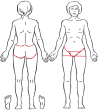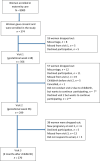Generalized joint hypermobility and the risk of pregnancy-related pelvic girdle pain: Is body mass index of importance?-A prospective cohort study
- PMID: 37614096
- PMCID: PMC10540924
- DOI: 10.1111/aogs.14664
Generalized joint hypermobility and the risk of pregnancy-related pelvic girdle pain: Is body mass index of importance?-A prospective cohort study
Abstract
Introduction: Pelvic girdle pain (PGP) affects approximately 50% of pregnant women. The mechanisms are multifactorial but not fully understood. Women with generalized joint hypermobility (GJH) may be vulnerable to load in the pelvic joints during pregnancy. Our aim was to investigate if women with GJH had an increased risk of PGP and higher pain intensity during and after pregnancy, compared with women with normal joint mobility. We also studied if body mass index (BMI) in early pregnancy influenced that risk.
Material and methods: A prospective cohort study of 356 women, whose data were collected by self-reports and clinical examinations in early and in late pregnancy and 9 months after childbirth. GJH was present with ≥5/9 points on the Beighton score. PGP was defined by a pain drawing and ≥1 positive test. Pain intensity was measured with a visual analogue scale (0-100 mm). We adjusted for age and origin in logistic regression and ordinal logistic regression analysis.
Results: In early pregnancy, 47.1% of the women with GJH had PGP vs 32.6% of women with normal joint mobility (adjusted odds ratio [aOR] 1.76; 95% confidence interval [CI] 0.86-3.62) and had higher odds of reporting higher pain intensity (aOR 2.04; 95% CI 1.02-4.07). The odds of PGP were highest for women with GJH and BMI ≥25 kg/m2 (aOR 6.88; 95% CI 1.34-35.27) compared with women with normal joint mobility and BMI <25 kg/m2 . The estimated associations were weaker and not statistically significant in late pregnancy or after childbirth.
Conclusions: Women with GJH did not have an increased risk of PGP during or after pregnancy but reported higher pain intensity in early pregnancy compared with women with normal joint mobility. Since women with combined GJH and BMI ≥25 kg/m2 had the highest odds of PGP in early pregnancy, our results may suggest that health care needs to pay attention to and develop methods to reduce the risk of PGP and delay the onset of pain during pregnancy in women with this combination.
Keywords: Uppsala pelvic pain study; body mass index; generalized joint hypermobility; pelvic girdle pain; pregnancy.
© 2023 The Authors. Acta Obstetricia et Gynecologica Scandinavica published by John Wiley & Sons Ltd on behalf of Nordic Federation of Societies of Obstetrics and Gynecology (NFOG).
Conflict of interest statement
The authors have stated explicitly that there are no conflicts of interest in connection with this article.
Figures


Similar articles
-
The Association of Self-Reported Generalized Joint Hypermobility with pelvic girdle pain during pregnancy: a retrospective cohort study.BMC Musculoskelet Disord. 2020 Jul 20;21(1):474. doi: 10.1186/s12891-020-03486-w. BMC Musculoskelet Disord. 2020. PMID: 32689990 Free PMC article.
-
Generalized joint hypermobility and risk of pelvic girdle pain in pregnancy: does body mass index matter?Physiother Theory Pract. 2022 Dec;38(12):2222-2229. doi: 10.1080/09593985.2021.1913774. Epub 2021 Apr 14. Physiother Theory Pract. 2022. PMID: 33849378
-
Prevalence and severity of low back- and pelvic girdle pain in pregnant Nepalese women.BMC Pregnancy Childbirth. 2019 Jul 15;19(1):247. doi: 10.1186/s12884-019-2398-0. BMC Pregnancy Childbirth. 2019. PMID: 31307421 Free PMC article.
-
[Relationship between perineal characteristics and symptoms and pelvic girdle pain: A literature review].Prog Urol. 2018 Mar;28(4):193-208. doi: 10.1016/j.purol.2017.12.007. Epub 2018 Jan 5. Prog Urol. 2018. PMID: 29307482 Review. French.
-
Pelvic Girdle Pain in Pregnancy: A Review.Obstet Gynecol Surv. 2023 Jun;78(6):349-357. doi: 10.1097/OGX.0000000000001140. Obstet Gynecol Surv. 2023. PMID: 37322996 Review.
Cited by
-
Effectiveness of a prenatal pilates program on ligamentous laxity and joint hypermobility in pregnant women: a dual-center randomized controlled trial.BMC Pregnancy Childbirth. 2025 Aug 28;25(1):897. doi: 10.1186/s12884-025-08082-1. BMC Pregnancy Childbirth. 2025. PMID: 40877820 Free PMC article. Clinical Trial.
-
Understanding and addressing female pelvic pain - a multifaceted challenge.Acta Obstet Gynecol Scand. 2023 Oct;102(10):1248-1249. doi: 10.1111/aogs.14682. Acta Obstet Gynecol Scand. 2023. PMID: 37773602 Free PMC article. No abstract available.
References
-
- Gutke A, Olsson CB, Vollestad N, Oberg B, Wikmar LN, Robinson HS. Association between lumbopelvic pain, disability and sick leave during pregnancy—a comparison of three Scandinavian cohorts. J Rehabil Med. 2014;46:468‐474. - PubMed
-
- Robinson HS, Mengshoel AM, Bjelland EK, Vollestad NK. Pelvic girdle pain, clinical tests and disability in late pregnancy. Man Ther. 2010;15:280‐285. - PubMed
-
- Bjelland EK, Stuge B, Engdahl B, Eberhard‐Gran M. The effect of emotional distress on persistent pelvic girdle pain after delivery: a longitudinal population study. BJOG. 2013;120:32‐40. - PubMed
-
- Rost CC, Jacqueline J, Kaiser A, Verhagen AP, Koes BW. Prognosis of women with pelvic pain during pregnancy: a long‐term follow‐up study. Acta Obstet Gynecol Scand. 2006;85:771‐777. - PubMed
-
- Bjelland EK, Eskild A, Johansen R, Eberhard‐Gran M. Pelvic girdle pain in pregnancy: the impact of parity. Am J Obstet Gynecol. 2010;203(146):e1‐e6. - PubMed
MeSH terms
LinkOut - more resources
Full Text Sources
Medical
Miscellaneous

